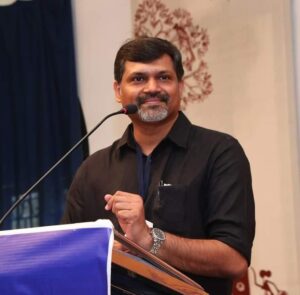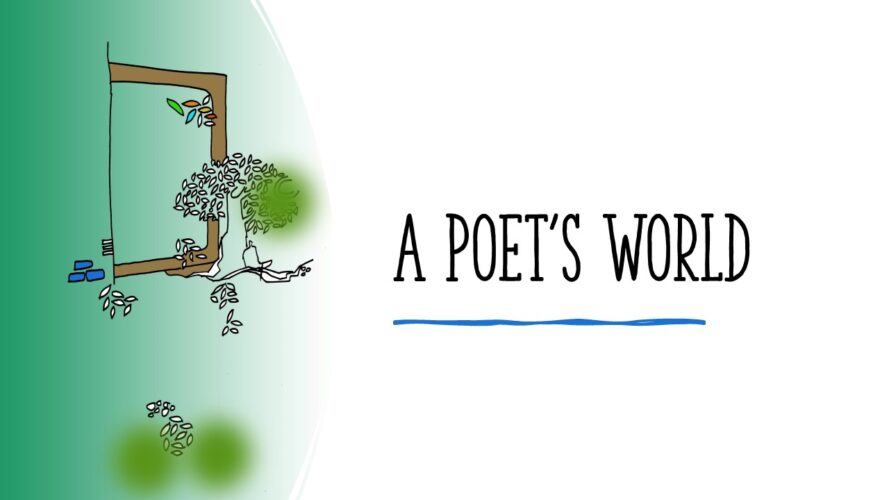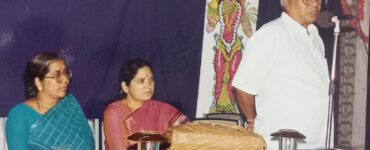Grew up in Palakkad of Kerala, Syam Sudhakar is known for his literary accomplishments in English and Malayalam. Always a pleasant presence in social media, Syam’s poetry articulates deep sensibilities of a Malayalee everyday life.
- When did you first write a poem? Can you recall a specific moment from the experience?
When I was in school, we used to exchange slips in class, often writing poetry with rhymes and meter, but those were never serious attempts. I think my first real poem came to me when I was reading A. Ayyappan, a bohemian Malayalam poet, during my senior school years. I discovered his work in my uncle’s collection one late evening when I was feeling bored. At the time, I was grieving the loss of my sister and entering a new phase of reading.
After that, I remember writing a poem in my diary, and my uncle remarked that it was quite something. Later, I named it “Earpam” (Damp), which also happened to become the title of my first collection. I was 18 then. The poem is about sudden turns in life, the smell of mortuary cotton, and how we all sometimes become like dead bodies even while we are alive.
- Tell us about your journey till now, how has your writing style evolved over time.
When my first poem was published, I received a couple of letters from a few senior writers, which gave me some confidence. From there, it was a sudden outpour. I published my first collection the following year, though I didn’t fully understand why or what I was writing—I just wrote.
Around the same time, my poems began appearing in Malayalam magazines. (The best part was that these magazines in Kerala paid their authors. I later learned that many magazines never really paid young writers in the neighbouring states).
I started thinking in English only after I moved to Chennai to do my post-graduation at Madras University. Initially, I tried translating my Malayalam poems into English, but I was dissatisfied with the results. Eventually, I started rewriting them instead. My friend Liz and Dr. Pitambarlal Rajani helped me check my writing style. My first English collection was dedicated to Liz; by then she passed away of cancer.
It was Dr. Christine Williams who opened up a new world for me, introducing me to international audience. She invited me to Sydney in 2009, where I read at the Brisbane Poetry Festival—my first international reading.
Looking back, I think my early poems were preoccupied with animals, dreams and death. My forthcoming collection Muziris marks a shift. I feel it is more about water and its flow, history and its exegesis.
- Can you name a recurring image or metaphor in your work, and explain its significance?
I think the recurring images in my poems are those of water, animals, and death. I was brought up in the state of Kerala—known for its plethora of monsoon stories (and more recently, notorious for its floods). During my childhood, I always happened to live near the river Bharathapuzha, which originates from the Anamudi peak and dissolves into the Arabian Sea. Our life, culture and even breath and words are deeply connected to this water body. I believe that Dr. C. S. Venkiteswaran identified the idea of fluidity that looms in my poems for this very reason. Dr. Anamika Chakraborty, who wrote a critical book on my works, points out the frequent presence of animals in my poems. I am proud to say that I am a lifelong lover of animals. The birds and animals that appear in my poems are from my own environment—ones I am familiar with and have personally met, not from any storybooks. Dr. Mandika Sinha and Dr. Razeena P. R. have pointed out the recurring motif of death in my poetry. How can a boy of fifteen or sixteen escape the idea of death after seeing his own sister’s hanging body? Once a stone crashes into the beautiful glass roof of your life, it can never truly be mended. From then on, everything you see—even a farmer who lost his crops to heavy monsoon, the legs of a child crossing the road, the never-ending floods and landslides, the climate bleeding into your drawing room through the television, the white feathers of a migratory dream—lies in the transitory space of silence between life and death.
- What’s your writing routine, ritual or process?
I never used to have a fixed writing routine in the past, but I noticed that mostly I wrote late at night, especially after 11 PM. But for the past nine to ten years, I’ve been working as a full-time literature teacher, and my nights are often preoccupied with academic readings.
Now, I try to write in the mornings, during the quiet hours when all my friends, even WhatsApp, Facebook and Instagram are asleep. Have you seen fishermen riding out to sea in the early morning?
- How do you see yourself in the intersection of the world we live in and the poems you write in your solitude? Do you think poetry has the power to influence social change?
Even though poetry is often a solitary endeavour, it serves a greater purpose. While it heals the poet’s mind, it also nurtures society. Much like the way roots of peas and beans enrich the soil with nitrogen, poets enrich society. Poetry heals.
*









Add comment